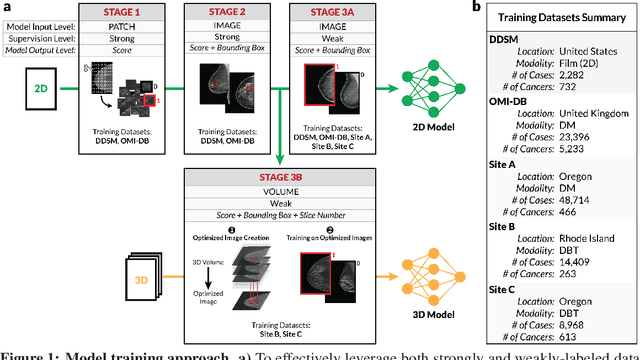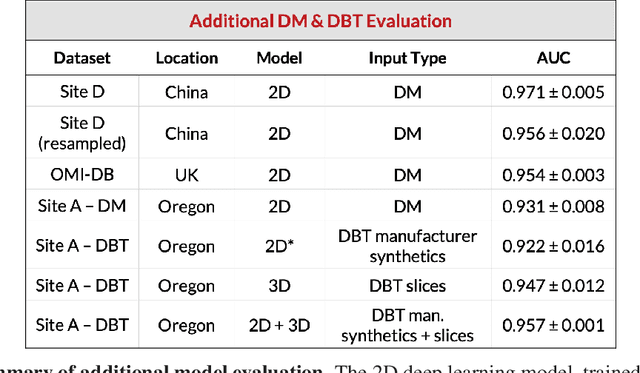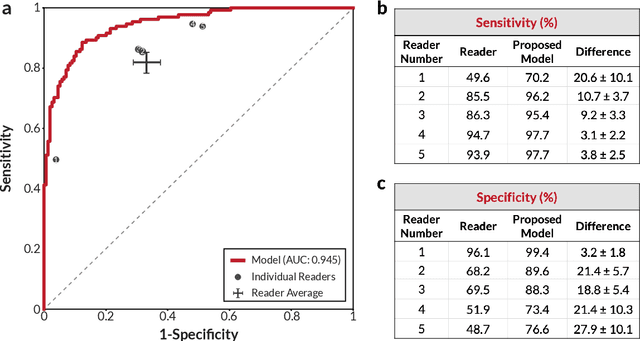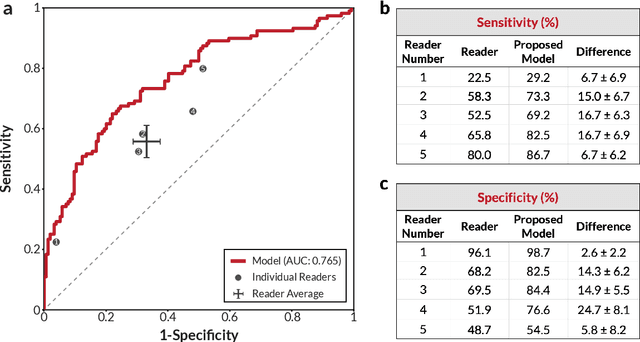William Lotter
Fluoroformer: Scaling multiple instance learning to multiplexed images via attention-based channel fusion
Nov 13, 2024



Abstract:Though multiple instance learning (MIL) has been a foundational strategy in computational pathology for processing whole slide images (WSIs), current approaches are designed for traditional hematoxylin and eosin (H&E) slides rather than emerging multiplexed technologies. Here, we present an MIL strategy, the Fluoroformer module, that is specifically tailored to multiplexed WSIs by leveraging scaled dot-product attention (SDPA) to interpretably fuse information across disparate channels. On a cohort of 434 non-small cell lung cancer (NSCLC) samples, we show that the Fluoroformer both obtains strong prognostic performance and recapitulates immuno-oncological hallmarks of NSCLC. Our technique thereby provides a path for adapting state-of-the-art AI techniques to emerging spatial biology assays.
Representing visual classification as a linear combination of words
Nov 18, 2023



Abstract:Explainability is a longstanding challenge in deep learning, especially in high-stakes domains like healthcare. Common explainability methods highlight image regions that drive an AI model's decision. Humans, however, heavily rely on language to convey explanations of not only "where" but "what". Additionally, most explainability approaches focus on explaining individual AI predictions, rather than describing the features used by an AI model in general. The latter would be especially useful for model and dataset auditing, and potentially even knowledge generation as AI is increasingly being used in novel tasks. Here, we present an explainability strategy that uses a vision-language model to identify language-based descriptors of a visual classification task. By leveraging a pre-trained joint embedding space between images and text, our approach estimates a new classification task as a linear combination of words, resulting in a weight for each word that indicates its alignment with the vision-based classifier. We assess our approach using two medical imaging classification tasks, where we find that the resulting descriptors largely align with clinical knowledge despite a lack of domain-specific language training. However, our approach also identifies the potential for 'shortcut connections' in the public datasets used. Towards a functional measure of explainability, we perform a pilot reader study where we find that the AI-identified words can enable non-expert humans to perform a specialized medical task at a non-trivial level. Altogether, our results emphasize the potential of using multimodal foundational models to deliver intuitive, language-based explanations of visual tasks.
Synthesizing lesions using contextual GANs improves breast cancer classification on mammograms
May 29, 2020



Abstract:Data scarcity and class imbalance are two fundamental challenges in many machine learning applications to healthcare. Breast cancer classification in mammography exemplifies these challenges, with a malignancy rate of around 0.5% in a screening population, which is compounded by the relatively small size of lesions (~1% of the image) in malignant cases. Simultaneously, the prevalence of screening mammography creates a potential abundance of non-cancer exams to use for training. Altogether, these characteristics lead to overfitting on cancer cases, while under-utilizing non-cancer data. Here, we present a novel generative adversarial network (GAN) model for data augmentation that can realistically synthesize and remove lesions on mammograms. With self-attention and semi-supervised learning components, the U-net-based architecture can generate high resolution (256x256px) outputs, as necessary for mammography. When augmenting the original training set with the GAN-generated samples, we find a significant improvement in malignancy classification performance on a test set of real mammogram patches. Overall, the empirical results of our algorithm and the relevance to other medical imaging paradigms point to potentially fruitful further applications.
Robust breast cancer detection in mammography and digital breast tomosynthesis using annotation-efficient deep learning approach
Dec 27, 2019



Abstract:Breast cancer remains a global challenge, causing over 1 million deaths globally in 2018. To achieve earlier breast cancer detection, screening x-ray mammography is recommended by health organizations worldwide and has been estimated to decrease breast cancer mortality by 20-40%. Nevertheless, significant false positive and false negative rates, as well as high interpretation costs, leave opportunities for improving quality and access. To address these limitations, there has been much recent interest in applying deep learning to mammography; however, obtaining large amounts of annotated data poses a challenge for training deep learning models for this purpose, as does ensuring generalization beyond the populations represented in the training dataset. Here, we present an annotation-efficient deep learning approach that 1) achieves state-of-the-art performance in mammogram classification, 2) successfully extends to digital breast tomosynthesis (DBT; "3D mammography"), 3) detects cancers in clinically-negative prior mammograms of cancer patients, 4) generalizes well to a population with low screening rates, and 5) outperforms five-out-of-five full-time breast imaging specialists by improving absolute sensitivity by an average of 14%. Our results demonstrate promise towards software that can improve the accuracy of and access to screening mammography worldwide.
Conditional Infilling GANs for Data Augmentation in Mammogram Classification
Aug 24, 2018


Abstract:Deep learning approaches to breast cancer detection in mammograms have recently shown promising results. However, such models are constrained by the limited size of publicly available mammography datasets, in large part due to privacy concerns and the high cost of generating expert annotations. Limited dataset size is further exacerbated by substantial class imbalance since "normal" images dramatically outnumber those with findings. Given the rapid progress of generative models in synthesizing realistic images, and the known effectiveness of simple data augmentation techniques (e.g. horizontal flipping), we ask if it is possible to synthetically augment mammogram datasets using generative adversarial networks (GANs). We train a class-conditional GAN to perform contextual in-filling, which we then use to synthesize lesions onto healthy screening mammograms. First, we show that GANs are capable of generating high-resolution synthetic mammogram patches. Next, we experimentally evaluate using the augmented dataset to improve breast cancer classification performance. We observe that a ResNet-50 classifier trained with GAN-augmented training data produces a higher AUROC compared to the same model trained only on traditionally augmented data, demonstrating the potential of our approach.
A neural network trained to predict future video frames mimics critical properties of biological neuronal responses and perception
May 30, 2018



Abstract:While deep neural networks take loose inspiration from neuroscience, it is an open question how seriously to take the analogies between artificial deep networks and biological neuronal systems. Interestingly, recent work has shown that deep convolutional neural networks (CNNs) trained on large-scale image recognition tasks can serve as strikingly good models for predicting the responses of neurons in visual cortex to visual stimuli, suggesting that analogies between artificial and biological neural networks may be more than superficial. However, while CNNs capture key properties of the average responses of cortical neurons, they fail to explain other properties of these neurons. For one, CNNs typically require large quantities of labeled input data for training. Our own brains, in contrast, rarely have access to this kind of supervision, so to the extent that representations are similar between CNNs and brains, this similarity must arise via different training paths. In addition, neurons in visual cortex produce complex time-varying responses even to static inputs, and they dynamically tune themselves to temporal regularities in the visual environment. We argue that these differences are clues to fundamental differences between the computations performed in the brain and in deep networks. To begin to close the gap, here we study the emergent properties of a previously-described recurrent generative network that is trained to predict future video frames in a self-supervised manner. Remarkably, the model is able to capture a wide variety of seemingly disparate phenomena observed in visual cortex, ranging from single unit response dynamics to complex perceptual motion illusions. These results suggest potentially deep connections between recurrent predictive neural network models and the brain, providing new leads that can enrich both fields.
A Multi-Scale CNN and Curriculum Learning Strategy for Mammogram Classification
Jul 21, 2017



Abstract:Screening mammography is an important front-line tool for the early detection of breast cancer, and some 39 million exams are conducted each year in the United States alone. Here, we describe a multi-scale convolutional neural network (CNN) trained with a curriculum learning strategy that achieves high levels of accuracy in classifying mammograms. Specifically, we first train CNN-based patch classifiers on segmentation masks of lesions in mammograms, and then use the learned features to initialize a scanning-based model that renders a decision on the whole image, trained end-to-end on outcome data. We demonstrate that our approach effectively handles the "needle in a haystack" nature of full-image mammogram classification, achieving 0.92 AUROC on the DDSM dataset.
Deep Predictive Coding Networks for Video Prediction and Unsupervised Learning
Mar 01, 2017



Abstract:While great strides have been made in using deep learning algorithms to solve supervised learning tasks, the problem of unsupervised learning - leveraging unlabeled examples to learn about the structure of a domain - remains a difficult unsolved challenge. Here, we explore prediction of future frames in a video sequence as an unsupervised learning rule for learning about the structure of the visual world. We describe a predictive neural network ("PredNet") architecture that is inspired by the concept of "predictive coding" from the neuroscience literature. These networks learn to predict future frames in a video sequence, with each layer in the network making local predictions and only forwarding deviations from those predictions to subsequent network layers. We show that these networks are able to robustly learn to predict the movement of synthetic (rendered) objects, and that in doing so, the networks learn internal representations that are useful for decoding latent object parameters (e.g. pose) that support object recognition with fewer training views. We also show that these networks can scale to complex natural image streams (car-mounted camera videos), capturing key aspects of both egocentric movement and the movement of objects in the visual scene, and the representation learned in this setting is useful for estimating the steering angle. Altogether, these results suggest that prediction represents a powerful framework for unsupervised learning, allowing for implicit learning of object and scene structure.
Unsupervised Learning of Visual Structure using Predictive Generative Networks
Jan 20, 2016



Abstract:The ability to predict future states of the environment is a central pillar of intelligence. At its core, effective prediction requires an internal model of the world and an understanding of the rules by which the world changes. Here, we explore the internal models developed by deep neural networks trained using a loss based on predicting future frames in synthetic video sequences, using a CNN-LSTM-deCNN framework. We first show that this architecture can achieve excellent performance in visual sequence prediction tasks, including state-of-the-art performance in a standard 'bouncing balls' dataset (Sutskever et al., 2009). Using a weighted mean-squared error and adversarial loss (Goodfellow et al., 2014), the same architecture successfully extrapolates out-of-the-plane rotations of computer-generated faces. Furthermore, despite being trained end-to-end to predict only pixel-level information, our Predictive Generative Networks learn a representation of the latent structure of the underlying three-dimensional objects themselves. Importantly, we find that this representation is naturally tolerant to object transformations, and generalizes well to new tasks, such as classification of static images. Similar models trained solely with a reconstruction loss fail to generalize as effectively. We argue that prediction can serve as a powerful unsupervised loss for learning rich internal representations of high-level object features.
 Add to Chrome
Add to Chrome Add to Firefox
Add to Firefox Add to Edge
Add to Edge